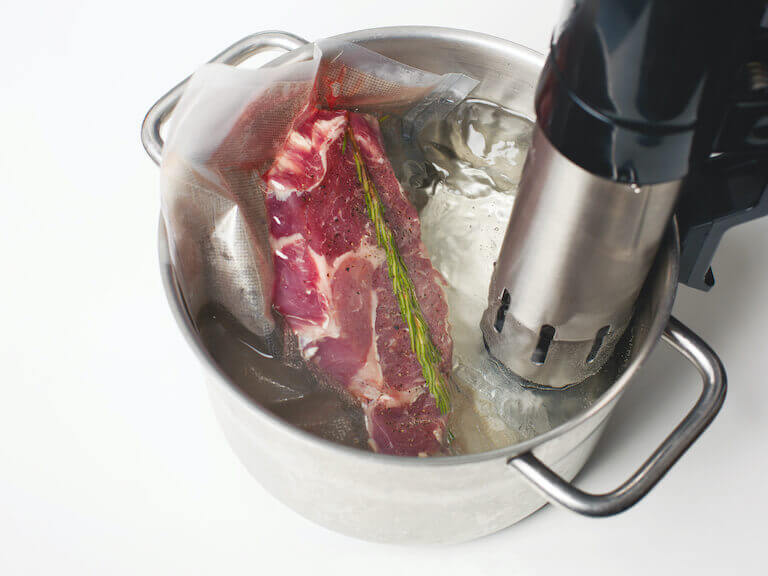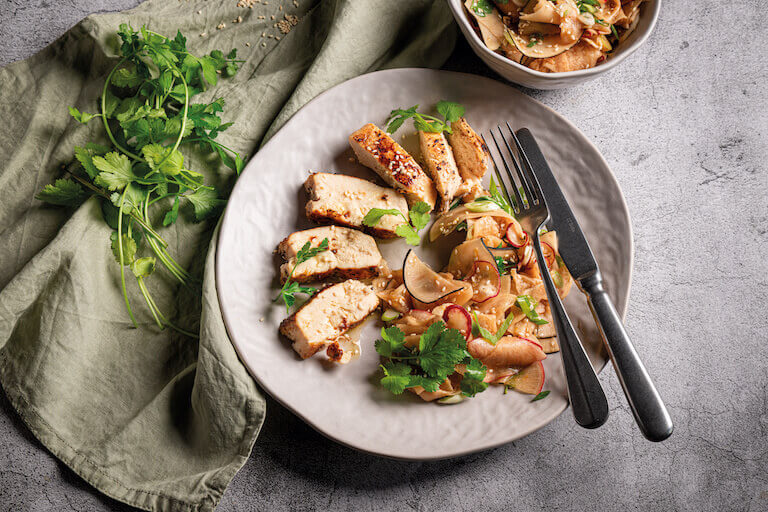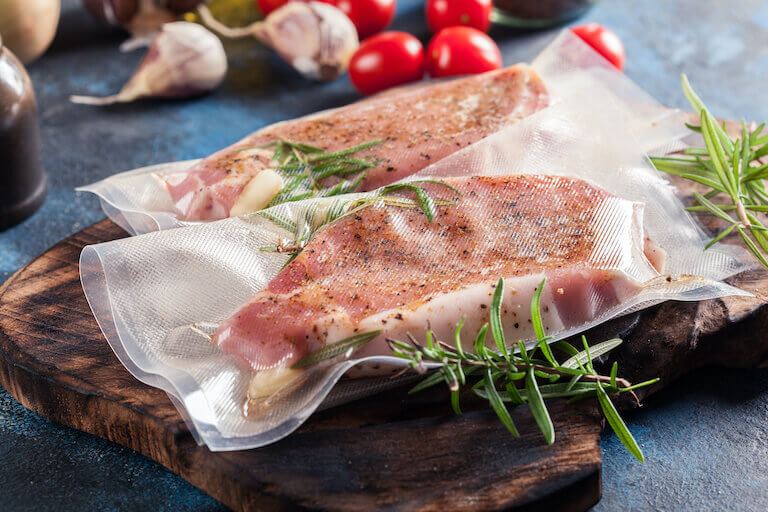Listen to This Article:
Have you ever wondered how some restaurants serve perfectly fork-tender steaks, poultry, and fish, and wished you could recreate the experience at home? Chances are, they’re preparing their dishes with a technique called “sous vide.”
Food that’s prepared by sous vide is tender, flavorful, and juicy even after hours of cooking. You will often see sous vide cooking taking place in professional kitchens, especially in fine dining restaurants.
Let’s dive into where sous vide cooking originated, the tools of the trade, how to do it, and some of the sous vide benefits that might encourage you to try it out for yourself.
What Is Sous Vide Cooking?
Sous vide is a cooking technique used to prepare a variety of proteins, vegetables, and more. It dates back to the 1960s and its backstory may surprise you. The term “sous vide” translates in French to “under vacuum,” which accurately describes the first step of this technique.
To use the sous vide method, a cook submerges vacuum-sealed food in a warm water bath. The water is kept at a constant temperature to slowly cook the food. This long and slow cooking method results in very tender, evenly cooked food that is moist and flavorful, and that melts in the mouth.

Perfectly cooked steak and poultry is the norm when you use the sous vide method.
How Was Sous Vide Cooking Invented?
Though the term “sous vide” is French, it is not a traditional French cooking technique, as you might suspect. Sous vide started as a technique centered on functionality. In fact, sous vide was invented in 1969 by U.S. cook Colonel Ambrose McGuckian, who was hired by A.G.S. Food System, Inc., to improve hospital food.
His technique involved cooking food all the way through in sealed plastic pouches, flash-freezing it until ready to use, and reheating it in a microwave oven.
This method was intended to cook and pasteurize food to extend its shelf life and improve the flavor of patient meals. By carefully controlling the cooking temperature, McGuckian was able to control and enhance the food’s flavor.
After word got out about this innovative method, French chefs began using and refining it. George Pralus and Bruno Goussault started experimenting with sous vide cooking and applying it to the more sophisticated dishes found in French cuisine.
Namely, they used this method to make meat more tender. Roast beef, Goussault noticed, did not shrink when cooked sous vide but rather came out juicy and evenly cooked. The chefs devised ideal cooking temperatures for different cuts of meat and utilized sous vide to prepare meals needing to be served right away rather than frozen and reheated.
What is “Precision Cooking”?
Precision cooking is a method that uses exact temperatures and cooking times to achieve consistent results and quality in a dish. Sous vide cooking is one of the main precision cooking methods, but precision ovens are another, which use steam and exact temperature control to bake, roast, or steam food uniformly.
Both methods use technology to provide a hyper-consistent cooking temperature and delicious, predictable results.
What You Need for Sous Vide Cooking
Sous vide cooking is easily accessible to the home cook with some simple equipment. Gather the following equipment to get started preparing professional quality dishes in your own kitchen:
A Sous Vide Precision Cooking Tool
The heart of the sous vide setup is the precision cooker, also known as an immersion circulator. This device heats and circulates water in the pot, maintaining a consistent temperature throughout the cooking process. There are several models available ranging from simple to feature-rich options with WiFi connectivity and mobile app integration.

An immersion circulator sits in the sous vide water bath and keeps the cooking temperature consistent throughout the process. Some have timers as well.
Vacuum Sealer and Plastic Bags or Pouches
To sous vide, you need to vacuum-seal your ingredients. A vacuum sealer removes all the air from the bag and seals it to prevent water from entering. You can use specifically designed sous vide bags or high-quality freezer bags in a pinch. The key is ensuring the bag is suitable for cooking at sustained high temperatures.

To cook sous vide successfully, ingredients must be vacuum-sealed. A vacuum sealer can help.
A Water Container, Such as a Pot or Tub for the Water Bath
While you can use a large pot for sous vide cooking, a dedicated water container might be a worthwhile investment. These containers are designed to be the right size for different cuts of meat and quantities of food. Some have lids or slots specifically to hold the immersion circulator, reducing heat loss and improving energy efficiency. If you don’t want to make that investment, a stock or soup pot works just fine, as long as it’s big enough to hold your bags.
Racks or Clips
To ensure even cooking, the bags must not touch each other or the sides of the container. Using racks or clips can help keep the bags separated and submerged. This ensures an even distribution of heat and prevents uneven cooking.
How to Sous Vide
Once your equipment is ready to go, season your ingredients using aromatics such as fresh herbs and spices to achieve the flavor profile you’re after, then place them in vacuum-sealed plastic pouches or bags. Next, wait until the water has reached your desired temperature and submerge the food in its water bath.
This is where a sous vide cooking tool comes in. Your immersion circulator will regulate the temperature of the water by circulating and heating it. Many will also time your cooking for you.
In sous vide cooking, the water temperature must stay the same throughout cooking. The idea is that food cooks gently from the inside out as heat is evenly distributed through both the water and the ingredients, so any harsh temperature changes—including sudden changes of even a couple of degrees—can lead to undesirable results.
Cooking sous vide is as much about science as it is about cooking. There is no guesswork—it’s all about time and temperature. For example, when you’re preparing a medium-rare strip steak sous vide style, a temperature of between 129 and 134 degrees is ideal and you should allow the steak to cook for between 45 minutes and four hours, depending on the weight of the steak.
The Science of Sous Vide
When you sous vide, raw ingredients are tenderized as their proteins slowly deform and their fibers and connective tissues dissolve. The cooking temperature determines which proteins denature and what textures result, not just how well done your food is.

Perfectly cooked sous vide chicken is mouthwateringly tender and delicious, served with a side of pickled turnips.
This is why the exact temperature of your water bath when you are cooking sous vide is incredibly important!
With that said, you don’t really need to do much after placing your ingredients in the water bath. Sous vide is much more hands-off than other cooking methods, and it’s difficult to overcook your ingredients.
Food safety is critical when you’re doing sous vide cooking. Punctured bags or a broken seal can lead to your food becoming contaminated and spoiling as the ingredients are exposed to oxygen. Be sure to check on your bags every so often to make sure that they’re still sealed completely. And always take the internal cooking temperatures of your food to ensure that it’s safe to eat before serving.
Benefits of Sous Vide
Sous vide cooking produces a particularly delectable result: tender, melt-in-your-mouth meats, and perfectly cooked vegetables. Here are a few other benefits of sous vide cooking:
Consistent Results
By using a precision cooker and repeatable timing and methods, you can be sure of getting consistent results every time you make a recipe. This is particularly true of meats. Sous vide cooking eliminates variations in doneness on the edges or in the center that may happen with traditional cooking techniques. This is especially important in a restaurant setting, where your customers want a repeat experience of their favorite dishes.
Better Flavor and Texture
Because sous vide food is cooked in a vacuum-sealed bag, it retains its moisture, marinades, and aromatics more effectively than in open-air cooking methods. This not only improves the flavor but also preserves the texture and integrity of ingredients, making dishes more tender and flavorful.
Better Preservation of Nutrients
Because sous vide cooking uses lower temperatures than traditional cooking methods, nutrients that are often lost through high-heat cooking are better preserved.
Convenience
Sous vide cooking allows you to set it and forget it. Once your dish is cooking in the vacuum-sealed bag, the precision cooker keeps the temperature consistent for the entire cooking time. There is virtually no danger of overcooking. This means you can do other things with your time, whether that’s preparing other dishes in a restaurant kitchen, or doing other tasks at home.
When to Sous Vide
Many foods can be cooked using sous vide, but high-protein ingredients respond particularly well to the low-and-slow cooking that sous vide allows.
The following ingredients are popular foods to sous vide:
- Lean or tough cuts of red meat
- Pork chops
- Fish such as salmon
- Shellfish such as lobster tail
- Eggs
- Chicken breast
- Duck breast
- Root vegetables such as carrots or parsnip
- Potatoes

Pork chops are a great food to prepare with sous vide because it’s nearly impossible to overcook them.
Steak is a great beginner recipe for cooking sous vide. There are many resources out there, like food blogs and cookbooks, to help you determine the right cooking times and temperatures for different types of steak. Try a semi-tender cut like strip steak or a lean cut like skirt steak to start, and experiment with adding aromatics and adjusting the cooking time.
A Short Guide to Sous Vide Cooking Times and Temperatures for Meats
There are many ways you can use the sous vide method to prepare your favorite dishes. As with regular cooking, people have a range of preferences when it comes to doneness, especially regarding meats.
The precision cooker allows you to create the perfect texture and flavor by consistently heating your ingredients. Here are some cooking times and temperatures for sous vide cooking. Please note that with sous vide meats, a chef typically dries off the cut once it’s cooked and sears in a pan or on the grill to crisp it up before serving. Be sure to consult with exact sous vide recipes for specifics.
Chicken
Chicken is considered done in a range from 145°F to 165°F, and will vary in tenderness depending on how long you hold it at these temperatures. Higher temperatures will produce a more fall-off-the-bone tender chicken, while the lower temperatures will give you a more juicy piece of chicken that holds together.
| Temperature Range | Minimum Time | Maximum Time |
|---|---|---|
| 145°F – 165°F | 1 hour 30 minutes | 8 hours |
Red Meat (Steak and Lamb)
The mark of a perfectly cooked steak or lamb is the exact shade of pinkness in the center, varying from rare through to well done. Sous vide makes obtaining the exact doneness easy, by setting the precision cooker to the exact temperature that gives you the perfect tinge of pink for your diners.
| Temperature Range | Minimum Time | Maximum Time |
|---|---|---|
| 129°F – 145°F | 1 hour 30 minutes | 4 hours |
Pork Chops
Pork chops are one of life’s great pleasures, but only if they’re properly cooked. It’s quite easy to overcook a chop in the pan or on the grill, rendering it stiff, tough, and gray. Cooks often worry about cooking pork thoroughly for food safety reasons, but this can be tricky to get right, too. Sous vide cooking guarantees a juicy, tender, perfectly cooked pork chop.
| Temperature Range | Minimum Time | Maximum Time |
|---|---|---|
| 135°F – 147°F | 1 hour | 4 hours |
Fish
- Fish is also easy to overcook, and difficult to keep moist, flaky, and tender. Using the precision cooker can help you get a perfectly cooked fish filet.
- Note: Fish that comes out of the sous vide bath may not stand up to finish browning or grilling.
| Temperature Range | Minimum Time | Maximum Time |
|---|---|---|
| 110°F – 132°F | 30 minutes | 1 hour 30 minutes |
- You can also use the sous vide method to cook vegetables, fruits, and even desserts. Find a reputable cookbook or app to guide you through what’s possible.
Learn the Art and Science of Sous Vide Cooking
Sous vide cooking can be time-consuming, but once you have the method down, it’s not difficult to execute. It can produce incredible food, including tender proteins and perfectly cooked veggies, and it’s a favorite cooking method among chefs, particularly those who favor French cooking.
Many chefs first learn to sous vide in culinary school, where Chef Instructors dive into the science of this technique and its many applications. A Culinary Arts degree or diploma from Escoffier may be right for you if you like the idea of a career in the kitchen.
IF YOU ENJOYED THIS ARTICLE ABOUT SOUS VIDE COOKING, CONSIDER READING THESE ARTICLES NEXT:
- Knife Skills: 10 Knife Cuts Every Professional Cook Should Know
- 13 Great Culinary Careers in the Food Industry
- How to Make the 5 Mother Sauces
This article was originally published on August 11, 2021 and has since been updated.

